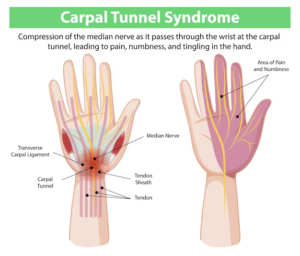Carpal Tunnel Syndrome Symptoms: Know What Your Hands Are Trying to Tell You?

Carpal tunnel syndrome is a common problem with the wrist. It occurs when swelling inside the carpal tunnel in your wrist puts pressure on the median nerve. This can cause symptoms like wrist pain, tingling, numbness, and weakness. Orthopedic might recommend treatments such as wearing a wrist splint, physical therapy, or surgery to relieve the symptoms.
Overview:
Carpal tunnel syndrome occurs when the median nerve in your wrist is pressed or irritated, causing symptoms like numbness, tingling, pain, and weakness in your hand and wrist.
What is carpal tunnel syndrome?

The carpal tunnel is a small space in your wrist made by bones. It’s like a tunnel that allows tendons, ligaments, and nerves to pass from your forearm to your hand.
Carpal tunnel syndrome happens when the median nerve inside this tunnel gets pinched or irritated. The median nerve helps move your forearm and gives feeling to most of your fingers and hand. If the nerve is squeezed, it can cause pain or numbness in your hand and wrist.
Symptoms & Causes
Symptoms
The symptoms usually happen along the path of the median nerve due to pressure on it. Your hand may often “fall asleep,” and you might drop things easily. Other symptoms include:
- It causes numbness, tingling, and pain in your thumb and first three fingers. If not treated, it can cause lasting nerve damage.
- Pain and a burning feeling that can spread up your arm.
- Wrist pain at night that can disturb your sleep.
- Weakness in the muscles of your hand.
Causes:
Most cases of carpal tunnel syndrome are caused by a mix of factors. Research shows that women and older adults are more likely to develop the condition.
Other risk factors include:
- Heredity: Some people may naturally have a smaller carpal tunnel, or certain traits that reduce space for the nerve, which can be passed down in families.
- Repetitive hand use: Repeating the same hand and wrist movements for long periods can irritate tendons, leading to swelling that presses on the nerve.
- Hand and wrist position: Holding your hand and wrist in extreme positions for too long can increase pressure on the nerve.
- Pregnancy: Hormonal changes during pregnancy can cause swelling that puts pressure on the nerve.
- Health conditions: Conditions like diabetes, and thyroid problems are linked to carpal tunnel syndrome.
- Ganglion cysts.
Several factors can increase the chances of swelling or inflammation in your wrists, including:
- Wrist injuries like sprains, dislocations, or broken bones.
- Being born with wrist joint issues.
- Regularly using vibrating tools.
- Jobs that involve repetitive gripping motions.
- Pituitary or thyroid gland disorders.
- Autoimmune conditions like rheumatoid arthritis that cause joint and tendon swelling.
- Fluid retention, such as during pregnancy or menopause.
- Being over 40 years old.
- Being assigned female at birth (AFAB).
Diagnosis and Tests
How is Carpal Tunnel Syndrome diagnosed?
Orthopedic will diagnose carpal tunnel syndrome by doing a physical exam and asking about your symptoms. They will look at your wrist, hand, and fingers and ask when you first noticed the symptoms and if certain activities or times of day make them better or worse.
Carpal Tunnel Tests
To confirm the diagnosis, doctor may use a mix of physical and imaging tests, including:
- Tinel’s sign
- Phalen’s test
- Wrist X-rays
- Electromyography (EMG)
- Ultrasound
- MRI (Magnetic Resonance Imaging)
Management and Treatment
What are the treatments for carpal tunnel syndrome?
Doctors usually start with nonsurgical treatments for carpal tunnel syndrome. If these treatments don’t work, surgery might be required.
Nonsurgical Treatments
Common treatments include changing your daily habits, supporting your wrist, and using medication:
- Wearing a splint (especially at night): A splint keeps your wrist in a neutral position, reducing pressure on the median nerve.
- Physical therapy: A therapist can help you strengthen your wrist muscles and improve flexibility.
- Changing posture or work environment: A therapist may suggest ways to adjust your posture or workspace to reduce strain on your wrist, like changing how you sit or position your keyboard.
- Over-the-counter medications: You may be advised to take NSAIDs or acetaminophen to reduce pain and swelling, but only for a limited time.
- Corticosteroids: Prescription anti-inflammatory medications, may be given directly into the carpal tunnel to reduce inflammation.
Carpal Tunnel Surgery
If nonsurgical treatments don’t help, your doctor may recommend carpal tunnel surgery. During the surgery, the surgeon performs a carpal tunnel release to make more room in your wrist. They will make a small cut in the ligament that connects your wrist to your palm (the transverse carpal ligament), reducing pressure on the carpal tunnel and allowing more space for your tendons and nerves.
Carpal tunnel surgery is typically an outpatient procedure, meaning you can go home the same day. Your surgeon will explain what to expect and provide instructions for recovery.
Health Note from Dr. Preetesh Choudhary:
Anything that affects your ability to feel or use your hands and fingers can be scary and frustrating, and carpal tunnel syndrome is no different. It occurs when irritation puts extra pressure on the median nerve in your wrist.
One might ignore pain, tingling, or numbness in your hand, especially if it comes and goes. However, don’t dismiss these symptoms. If not treated, carpal tunnel syndrome can cause lasting nerve damage. The good news is that it’s treatable, and your doctor can help you find ways to ease your symptoms and protect your wrist.






